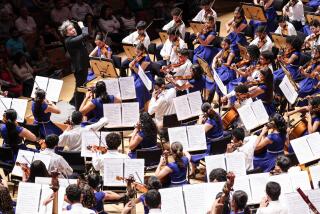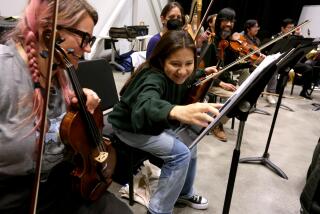MUSIC / CHRIS PASLES : Trio Lives Up to Tchaikovsky
IRVINE — Moscow was always an important city for Tchaikovsky. Even before he graduated from the St. Petersburg Conservatory, the composer took a teaching post at the fledgling Moscow Conservatory. It was a job he maintained off and on for nearly 20 years, and his presence was felt in the city for the rest of his career.
It might be safe to assume, then, that there is some kind of unbroken Tchaikovsky performance tradition at the Moscow Conservatory.
Certainly the members of the veteran Borodin Trio--violinist Rostislav Dubinsky, cellist Yuli Turovsky and pianist Luba Edlina--who were trained there, offered what sounded persuasively like an authoritative account of the composer’s Trio in A minor Monday at the Irvine Barclay Theatre.
The concert, part of a series jointly sponsored by the Laguna Chamber Music Society and the Orange County Philharmonic Society, also included works by Frank Martin and Beethoven.
The Moscow tradition, as revealed on this occasion, does not necessarily prize neatness, objectivity or subtlety. But it does allow for full-throated expressivity, welcome ebb and flow of tempo and unfolding of line, and seamless transitions among passages of the folk-like simplicity, Slavic moodiness and imperial ceremony that partly define the composer’s style.
Turovsky provided the most fervent, prominent voice, sweeping in line and bold in expression. Dubinsky, who may have had untypical pitch problems, tended to sound edgy and self-effacing, though he did contribute moments of sweetness. Edlina was an unfailingly strong, poised and stylish partner.
There are other ways to play this music, but the players seemed fully comfortable with the composer’s demands.
Their strengths were evident also in Martin’s thorny “Trio sur des Melodies Populaires Irlangaises”, a 1925 work that shifts unexpectedly from easy, foot-stamping jigs to passages of compacted line and manic energy.
The players maintained a steady momentum in the long acceleration of the first movement. Their discourse in the second movement sounded tight and clotted, but they compensated with bracing reassertions of independence in the pungent counterpoint of the final movement.
In Beethoven’s “Ghost” Trio, the three played with sympathetic similarity of gesture and attack, finely matched dynamics when passing ideas from one to another, and well-judged balance in ensemble. Some of the depths in the work eluded them, but the slow movement was sufficiently eerie to warrant the popular title.
They played the Scherzo from Mendelssohn’s Trio No. 1 as an encore.
More to Read
The biggest entertainment stories
Get our big stories about Hollywood, film, television, music, arts, culture and more right in your inbox as soon as they publish.
You may occasionally receive promotional content from the Los Angeles Times.










